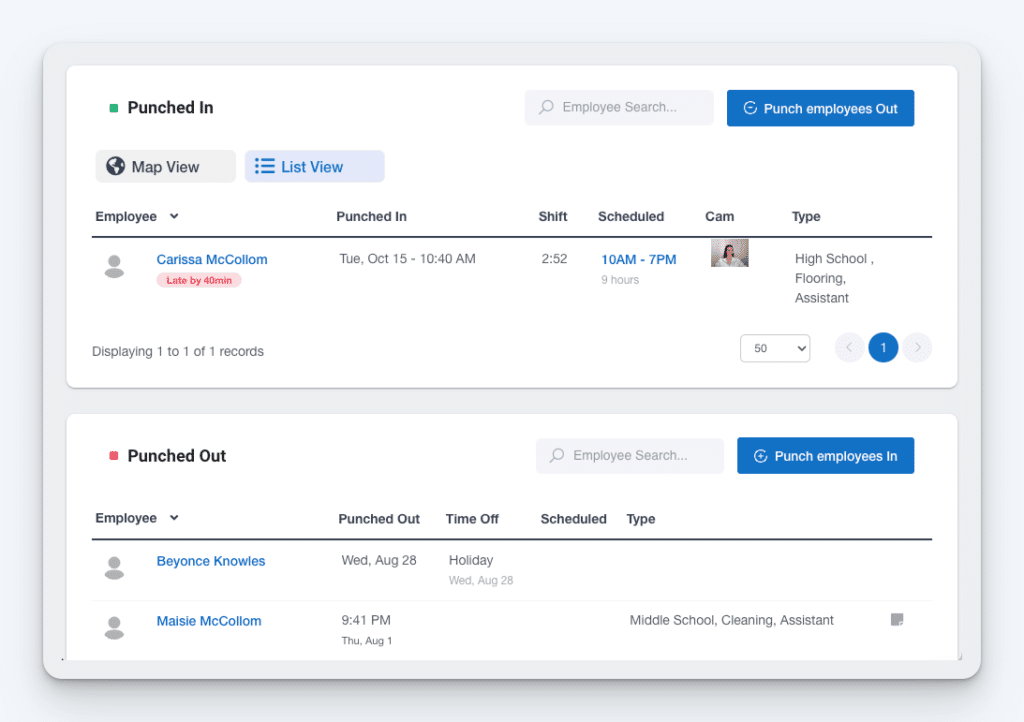What to Say to an Employee Who Falsifies Their Time Card
Time card fraud is a common problem for business owners. Here’s how to combat it, how to identify it, and what to say to an employee who commits it.

Unfortunately, falsification of timesheets is a common problem.
In fact, one out of every five workers participate in time card fraud by buddy punching (clocking in or out for another employee), and 43 percent of hourly workers admit to exaggerating their work hours during shifts.
While time card fraud is not as severe as stealing money out of the cash register — and it won’t lead to criminal charges except in the most severe situations — falsifying timesheets still counts as theft and should be taken just as seriously.
But how do you confront a worker whom you suspect has been falsifying time card data? What do you say to them without impacting employee morale? Confrontation can be a challenge — especially when it involves an issue that’s as sensitive as time card falsification.
To help you get started, here are a few basic steps that will help you to ensure that your conversation with your employee is as straightforward, productive, and professional as possible.
If employee time theft is a problem for your business, you might want to consider Buddy Punch’s time tracking software. It comes with several features to help you stop time theft altogether. You can prevent employees from clocking in and out while offsite with geofences, require them to take selfies when clocking in and out to prevent buddy punching, and even follow their movements in real-time across the entire workday.
What is time card fraud?
Time card fraud is when an employee falsifies their work hours to receive pay they didn’t earn. This can be done for a number of reasons, such as disguising a long break, trying to pad overtime pay, or hiding absenteeism. While timesheet fraud is not explicitly against any federal laws, it does interact with certain labor laws that makes it effectively illegal.
The 3 most common types of time card fraud
If you’re concerned about time card fraud at your business, it’s important to first understand the most common ways that employee commit it.
1. Inflation of work hours
This occurs when an employee lies about their start and/or end times in order to make it look like they worked more than they really did. This is particularly costly when the inflated hours cause the employee to earn overtime pay. Companies using manual timekeeping methods are particularly susceptible to this method because employees can simply write down whatever start and end times they want to be paid for.
2. Inaccurate break times
Another common type of time card fraud is employees either taking overly long breaks or taking unauthorized paid breaks. Many employers offer their employees two 15-minute paid breaks over an eight-hour shift and one unpaid 30-minute break. However, some employees may take more than two paid breaks during a shift or take a lunch longer than 30 minutes without subtracting those hours from their time cards.
3. Buddy punching
Buddy punching happens when one employee punches in for another in order to disguise an absence or cover for lateness. This is extremely common among friends and can have a detrimental effect on employee morals if other team members notice it but management doesn’t.
How to deal with time card fraud in your business
If you’re confident that one of your employees is committing time theft, follow the process below to have a straightforward, productive, and professional conversation with the employee about the issue.
Practice discretion
Discretion is always vital in the workplace — and especially so with an issue like employee time theft. Notify your worker — via email or through other discrete method — that you’d like to speak with them privately in your office. Never announce it loudly in front of a group of coworkers or discuss details of the issue openly with anyone whom it doesn’t concern.
Start with general questions
While you aren’t having your employee come into your office for small talk, you’ll want to take a minute to lead into the issue. You want to have an honest and open conversation, and a nervous employee can appear guilty even if they aren’t. Ask relevant but leading questions regarding their typical daily routine to help to provide context for the issue, making it easier to transition the conversation into the discussion at hand.
Ensure the employee knows your company policy
Having a written attendance policy in place is important for moments such as these. Before you get into the specifics, you’ll want to confirm that your employee is aware of and understands your attendance policy.
Ideally, you should have their signature on file showing that they read and understood the employment agreement when they were hired. At this time, you should ask your employee to explain the policy regarding timesheets to you. Ask if they feel that falsifying time card data is acceptable and if there are specific situations that warrant such actions.
Related: Time Clock Rules for Hourly Employees
Ask specific questions
Get specific with your questions. Ask where your employee was on a certain workday and how many hours they worked. Present the evidence you have against them, and show them how their claims conflict with the amount of time they worked in actuality. Then, ask them for an explanation for the discrepancy.
Consider their explanation
Try to keep an open mind when it comes to the conversation. This is especially true for employees who have had a great track record or have been with you for a long period of time without incident. It is entirely possible that there was a mix up or an honest mistake — maybe a lunch break ran long or a personal phone call derailed their productivity.
Give your employee a chance to explain his/herself before you determine the next course of action.
Take disciplinary action
After you’ve gathered the facts, you can let your worker leave. Tell them that you’ll get back to them with your decision. Ideally, your employee handbook should outline what actions will be taken in the event of employee time card fraud or falsification, and it’s important to follow procedure. This will set the standard for other employees as well.
If you don’t have any systems in place, it’s important to ensure that the disciplinary action that you take is commensurate with the level of fraud they have committed. For a first-time offense, you may want to let your worker off with a written or verbal warning. For more serious cases, further disciplinary action may need to be taken.
Falsifying time card data is a serious concern for companies today, and one that, in extreme cases, can even be considered a form of larceny, carrying the risk of potential jail time and fines.
No matter what course of action you decide to take, it’s important to ensure that you send the message to your team that you take time fraud seriously and that the company will not tolerate any form of theft — no matter how insignificant it may seem.
Prevent time card fraud with Buddy Punch

The American Payroll Association found that using time and attendance software — especially any sort of time tracking that included biometrics — was the most effective way to prevent time theft.
Our time tracking software, Buddy Punch, offers tons of features that help employers prevent time theft entirely. You can set up geofences or IP address locks to prevent employees from clocking in or out before they arrive at work or after they leave, and you can use facial recognition and require employees to take pictures or themselves when clocking in and out to prevent buddy punching.
Furthermore, you can log employees’ locations when they punch in and out to identify time theft, track their locations in real-time to see if they’re running errands while they’re on the clock, and even see which employees tried to clock in our out while offsite. All of these features are optional. You can make them required for all employees — or just for specific employees you have concerns about.
In addition to helping you prevent time card fraud, Buddy Punch gives you all of the tools you need to run your business effectively. You can track employees’ hours, create work schedules, calculate PTO accruals, track attendance even when employees work in the field, and run payroll quickly and accurately.
Learn more about Buddy Punch
- Start a free trial — no credit card required
- View pricing
- Watch a video demo
- Take an interactive product tour
- Request a personalized demo
Preventing time card fraud is the employer’s responsibility
Small businesses often don’t have systems in place to easily identify time theft, but that doesn’t mean that you should let time card fraud go unchecked. The Fair Labor Standards Act (FLSA) requires employers to maintain accurate time records for their employees, which means it’s your responsibility to ensure your employees’ time cards are correct.
In many states, it can be difficult and time-consuming to make a deduction to an employee’s wages after the fact to account for time card errors (at least in a way that’s compliant with the law). It’s much more straightforward if you catch the fraud within the same pay period that the falsification occurred. This allows you to correct the time record before the employee is paid.
In other words, it’s crucial that you take action the moment employees steal company time. You want to stop the problem before it escalates further and impacts your bottom line.
How a time card app can help
One of the most effective ways to deter and detect time theft is by using a dedicated time card app. The best clock in and out apps often include built-in features like GPS tracking, facial recognition, or geofencing, making it easier to catch inaccuracies and maintain compliance with laws like the Fair Labor Standards Act.
By identifying potential issues quickly, you can correct fraudulent entries during the same pay period and avoid wage deduction complications down the line.


